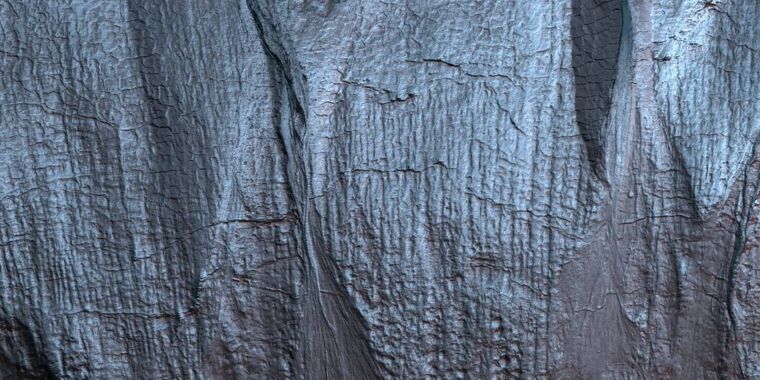Mars’ Gullies: Shaped by More Than Just Water
Mars has a rich history of liquid water on its surface, evident from the presence of dried-up lakes like the one that once occupied Jezero Crater. Previously, scientists believed that gullies on Mars were solely shaped by ancient water and melted water ice. However, recent discoveries challenge this view by suggesting that dry ice, or frozen carbon dioxide, also plays a significant role in shaping the Martian landscape.
The Role of Sublimation
Traditionally, it was believed that liquid water was the primary force responsible for shaping gullies on Mars, drawing parallels from Earth. What scientists failed to consider was the process of sublimation, which involves the direct transition of a substance from a solid to a gaseous state. This phenomenon, observed in CO2 ice as well as water ice, can lead to significant changes in the Martian terrain.
The presence of frozen carbon dioxide across Mars, including within its gullies, sheds light on a new mechanism of landscape transformation. When CO2 ice sublimates within these gullies, the resulting gas can displace debris downhill and contribute to the shaping process.
New Findings
Under the leadership of planetary researcher Lonneke Roelofs from Utrecht University, a team of scientists has presented evidence suggesting that the sublimation of CO2 ice may have played a key role in shaping Martian gullies. This discovery raises questions about the timeline of liquid water activity on Mars, indicating that it may have occurred further in the past than previously assumed. It also prompts speculation on the potential window for life to emerge and thrive on the red planet.
“Sublimation of CO2 ice, under Martian atmospheric conditions, can fluidize sediment and creates morphologies similar to those observed on Mars,” as stated by Roelofs and her collaborators in a recent study published in Communications Earth & Environment.
Comparison with Earth’s Gullies
While Earth and Mars display similar gully morphologies, the continuous shaping of gullies on Earth is attributed to liquid water activity. However, the present surface of Mars lacks the required stable liquid water for sustained shaping processes. This is where sublimation emerges as a crucial factor in altering the Martian landscape, observed alongside the flow of material on the surface.
Examining such observations, researchers theorize that sublimation-driven flows occur when frozen carbon dioxide transforms into gas, exerting enough force to induce fluid motion in the material. The lower atmospheric pressure on Mars amplifies the impact of sublimation, generating sufficient energy for material displacement.
Experimental Insights
To substantiate these theories, researchers turned to experimentation due to the absence of human exploration on Mars. Through the construction of a Mars-like environment in a laboratory setting, using a flume and specialized chamber to mimic Martian conditions, scientists were able to observe the effects of CO2 sublimation on debris movement. By introducing warmer slopes adjacent to CO2 ice formations, the team successfully replicated the flow patterns hypothesized to occur on Mars.
Two additional experiments conducted under Earth-like pressures and without CO2 ice failed to produce similar flows, underscoring the unique role of sublimation in shaping Martian gullies. These findings provide strong evidence that CO2 sublimation can drive granular flows under Martian atmospheric conditions.
Implications for Martian Habitability
The implications of these experiments extend to the understanding of Martian habitability and the potential presence of life on the planet. By showcasing the significance of sublimation in shaping gullies, this research challenges previous assumptions about the duration of liquid water availability on Mars. While Roelofs’ findings do not definitively rule out the possibility of past life on Mars, they offer new perspectives on planetary habitability and the conditions required for it.
Ultimately, this study sheds light on the intricate interplay of geological processes on Mars and invites further exploration into the evolution of the red planet.
Communications Earth & Environment, 2024. DOI: 10.1038/s43247-024-01298-7
Image/Photo credit: source url





